Vietnam: Method for determining the cost of production of domestically produced goods and services
Below is the content of the method for determining the production cost of domestically produced goods and services as stipulated in Circular 45/2024/TT-BTC of the Ministry of Finance of Vietnam dated July 01, 2024.

Method for determining the cost of production of domestically produced goods and services (Image from the Internet)
On July 1, 2024, the Minister of Finance of Vietnam issued Circular 45/2024/TT-BTC on the common pricing methods for goods and services priced by the State, which includes regulations related to depreciation costs of fixed assets directly in the production cost of domestically produced goods and services.
Methods for determining the production cost of domestically produced goods and services
Specifically, according to Article 9 of Circular 45/2024/TT-BTC, the production cost of domestically produced goods and services is regulated as follows:
- Direct material costs include the costs of raw materials, materials, tools, drugs, chemicals, instruments, fuel, energy, and other supplies (hereinafter referred to as materials) used directly for producing goods and services.
Material costs are determined as follows:
Material cost = Material consumption norm x Material price
+ Material consumption norm is determined based on economic-technical standards issued by state agencies;
+ Material price
The material price used to calculate the price of goods and services is determined in accordance with the standards, types, and quality of the materials used, considering the location of production. To be specific:
For materials priced by the State: price is calculated according to State regulations plus (+) reasonable and valid costs (if any).
For materials not priced by the State: calculated according to invoice prices and documents as per legal regulations, minus commercial discounts, purchase price reductions (if any), and other reductions (if any). If there are incomplete invoices or documents, the price is determined according to the provisions of Articles 13, 14, and 15 of Circular 45/2024/TT-BTC plus (+) reasonable and valid costs to bring the materials to the unit’s warehouse (if any). In cases where materials are purchased from individuals or households without invoices as per tax regulations, a purchase statement must be prepared as per tax legal requirements.
For directly imported materials used in production: calculated according to the import cost regulations at point a, clause 1, Article 7 of Circular 45/2024/TT-BTC.
For self-manufactured materials: calculated according to the actual warehouse issuance price plus (+) reasonable and valid costs during the manufacturing process (if any).
For outsourced processed materials: calculated as the actual warehouse issuance price for outsourcing plus (+) processing costs plus (+) reasonable and valid expenses to transfer the materials for processing (if any) and back to the unit’s warehouse (if any).
The prices of various materials, outsourced processing, transportation, storage, procurement, and other expenses (if any) must be recorded on invoices and documents following legal regulations.
- Direct labor costs
+ Direct labor costs include payments for direct production workers, such as wages, salaries, salary-related allowances, social insurance contributions, health insurance, unemployment insurance, and union fees for direct production workers as per the Labor Code, state policies, and relevant laws;
+ Salary costs are determined as follows:
Salary cost = Labor norm x Salary unit price
The labor norm is determined based on economic-technical standards issued by competent state authorities.
The salary unit price is implemented following wage regulations and relevant laws;
+ Labor costs are determined based on economic-technical norms, labor contracts, collective labor agreements, and other lawful agreements as per labor laws, relevant laws, and internal expenditure regulations for units required to issue such regulations.
- Depreciation costs of direct fixed assets
The depreciation cost of fixed assets is implemented according to regulations of the Ministry of Finance on policies for the management, usage, and depreciation of fixed assets.
In cases where the depreciation cost of fixed assets directly serving production and business has already been included in the overall production costs, it is not calculated under clause 3, Article 9 of Circular 45/2024/TT-BTC.
- General production costs
General production costs include costs for overall production activities incurred at workshops, departments, units, teams, sections, construction sites, and other segments (hereinafter referred to as workshops) as per legal regulations for supporting the production and business of goods and services, including:
+ Workshop staff costs: salary payments, salary-related allowances for workshop management staff, social insurance contributions, health insurance, unemployment insurance, and union fees as per the Labor Code, state policies, and relevant laws;
+ Material costs for workshops such as materials for fixed asset repairs used in workshops, materials for workshop management, and temporary shelter costs;
+ Depreciation costs of fixed assets used for workshop activities are implemented in accordance with the Ministry of Finance’s regulations on policies for managing, using, and depreciating fixed assets. If already calculated under clause 3, Article 9 of Circular 45/2024/TT-BTC, it is not calculated under clause 4, Article 9 of Circular 45/2024/TT-BTC;
+ Outsourced service costs for workshop activities, such as electricity, water, telephone, fixed asset repairs, fixed asset rentals, contractor payments (if any), and other outsourced costs (if any);
+ Other reasonable and valid monetary costs as per legal regulations for workshop activities, aside from the aforementioned costs.
- Other reasonable and valid costs (if any) as per legal regulations for production not mentioned above.
Regulations on pricing methods and selecting pricing methods
- The general pricing method for goods and services priced by the State as regulated in Circular 45/2024/TT-BTC includes two (02) pricing methods: the cost method and the comparison method.
- Based on the characteristics of goods and services, specific conditions of production, business, market, and the flow of goods and services, organizations and individuals shall choose a suitable pricing method for the goods and services.
(Article 4 of Circular 45/2024/TT-BTC)
Le Nguyen Anh Hao
- Key word:
- method for determining cost
- Number of deputy directors of departments in Vietnam in accordance with Decree 45/2025/ND-CP
- Cases ineligible for pardon in Vietnam in 2025
- Decree 50/2025 amending Decree 151/2017 on the management of public assets in Vietnam
- Circular 07/2025 amending Circular 02/2022 on the Law on Environmental Protection in Vietnam
- Adjustment to the organizational structure of the Ministry of Health of Vietnam: Certain agencies are no longer listed in the organizational structure
- Vietnam aims to welcome 22-23 million international tourists in Vietnam in 2025
-

- Notable new policies of Vietnam effective as of ...
- 16:26, 11/04/2025
-
.Medium.png)
- Notable documents of Vietnam in the previous week ...
- 16:21, 11/04/2025
-
.Medium.png)
- Notable documents of Vietnam in the previous week ...
- 16:11, 02/04/2025
-
.Medium.png)
- Notable new policies of Vietnam to be effective ...
- 16:04, 02/04/2025
-
.Medium.png)
- Notable new policies of Vietnam effective from ...
- 14:51, 21/03/2025
 Article table of contents
Article table of contents
